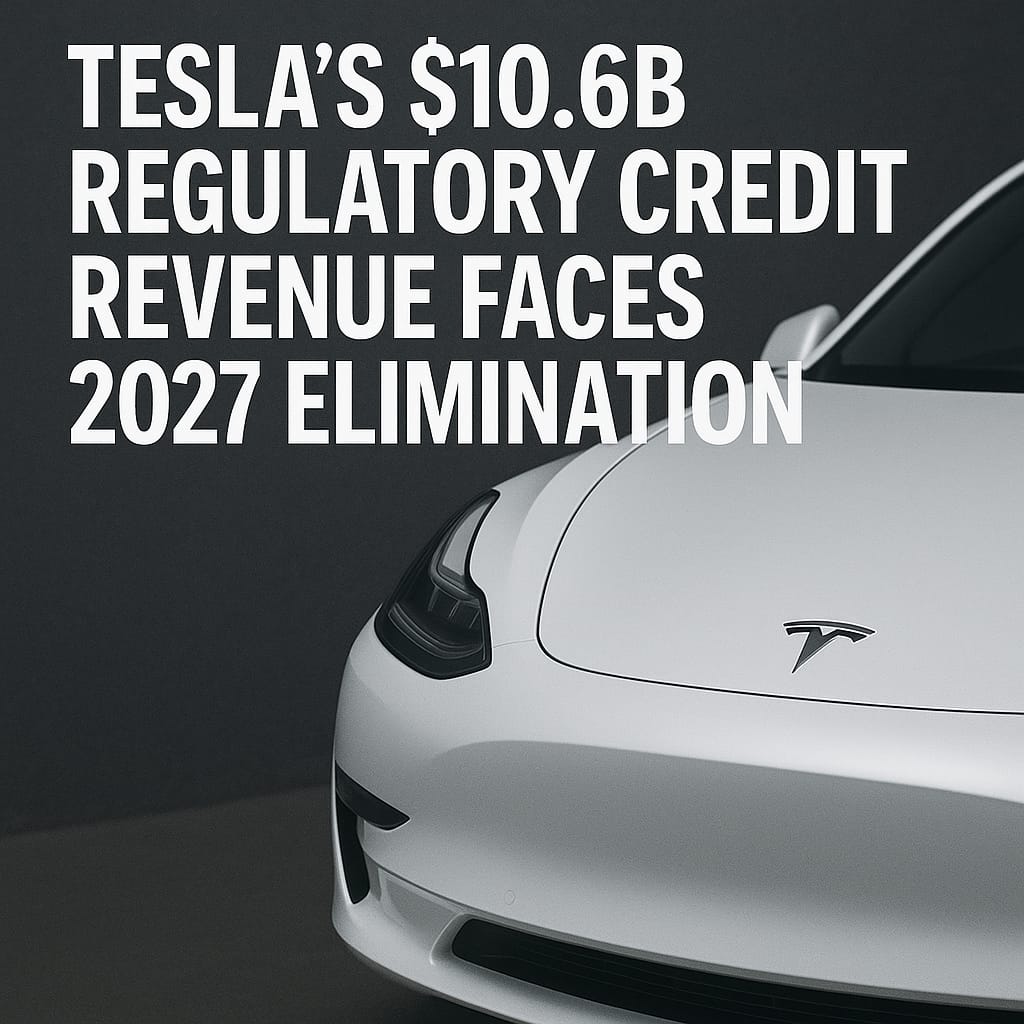
Tesla’s $10.6 Billion Regulatory Credit Revenue Stream Faces Elimination Under New U.S. Policy Changes
Tesla’s lucrative regulatory credit business, which has generated over $10.6 billion since 2019, faces complete elimination by 2027 following sweeping policy changes under the Trump administration. The electric vehicle manufacturer’s dependence on these credits has become increasingly critical as vehicle sales decline and profit margins shrink.
Policy Shift Threatens Tesla’s Financial Stability
The recently passed Republican tax and spending bill, signed into law on July 4, 2025, removes financial penalties for automakers failing to meet Corporate Average Fuel Economy (CAFE) standards. This fundamental change eliminates the primary incentive for traditional automakers to purchase regulatory credits from Tesla.
William Blair analysts project Tesla’s regulatory credit revenue will plummet by 75% in 2026, falling from approximately $2.4 billion to just $595 million, before disappearing entirely in 2027. This represents a significantly faster decline than previously anticipated by Wall Street analysts.
Critical Revenue Source at Risk
Regulatory credits have played an outsized role in Tesla’s profitability. In the first quarter of 2025, Tesla earned $595 million from credit sales while reporting only $420 million in net income – meaning the company would have posted a loss without this revenue stream.
“These regulatory credit sales are the reason that Tesla exists today,” noted Gordon Johnson, a Wall Street analyst critical of Tesla’s business model. The credits have provided nearly pure profit, with virtually no production costs associated with generating them.
Market Dynamics and Buyer Relationships
Legacy automakers including Ford, General Motors, and Stellantis have been major purchasers of Tesla’s credits. Ford alone disclosed contracts worth $3.8 billion for regulatory compliance credits, including $100 million spent in Q2 2024.
Tesla currently holds long-term contracts to sell $4.7 billion in credits, though industry experts suggest some automakers may attempt to exit these agreements early given the eliminated penalties.
Broader Impact on Electric Vehicle Market
The policy changes extend beyond regulatory credits. The $7,500 federal tax credit for electric vehicle purchases will end on September 30, 2025, potentially dampening consumer demand. JPMorgan analysts estimate this could cost Tesla an additional $1.2 billion in annual profit.
Dan Becker, director of the Safe Climate Transport Campaign, observed that these changes are “making conventional ICE vehicles more competitive while making EVs less competitive,” potentially slowing the broader transition to electric vehicles.
Tesla’s Strategic Response
Facing this revenue cliff, Tesla CEO Elon Musk has emphasized autonomous driving and robotics as future growth drivers. The company plans to expand its robotaxi service to cover half the U.S. population by year-end, pending regulatory approvals.
However, these initiatives have yet to generate significant revenue, leaving investors concerned about near-term profitability as traditional revenue streams decline.
Historical Context and Future Implications
Since 2012, regulatory credits have accounted for 34% of Tesla’s total $32 billion in cumulative profits. The company’s ability to generate these credits by producing only zero-emission vehicles has provided a crucial competitive advantage over traditional automakers.
As Tesla’s Chief Financial Officer Vaibhav Taneja acknowledged during the Q2 2025 earnings call, “While we never plan our business around such sales, it will nonetheless impact our total revenue.”
International Markets Offer Limited Relief
While European and Asian markets continue to offer regulatory credit opportunities, Tesla faces challenges there as well. Declining sales in Europe – including a 49% drop in April 2025 – may impact the company’s ability to generate sufficient credits to meet existing commitments to manufacturing pools.
The International Council on Clean Transportation warns that Tesla may struggle to deliver promised credits to partners like Stellantis if sales continue to underperform in key European markets.
Industry-Wide Implications
The elimination of CAFE penalties represents a significant victory for traditional automakers, who will save billions in compliance costs. This policy shift effectively removes a key mechanism that has accelerated electric vehicle adoption and subsidized EV manufacturers’ growth.
As the regulatory landscape transforms, Tesla must accelerate its pivot toward new revenue streams while managing the decline of a business model that has sustained its growth for over a decade. The company’s ability to navigate this transition will determine whether it can maintain profitability in an increasingly competitive electric vehicle market without the regulatory credit cushion that has supported it since inception.






